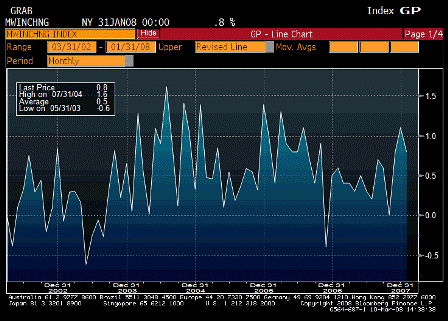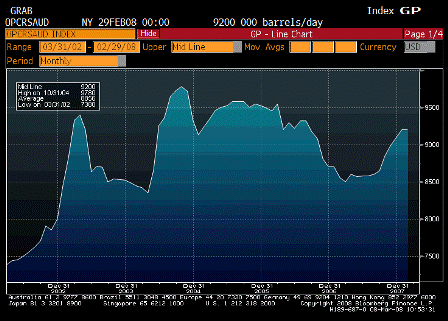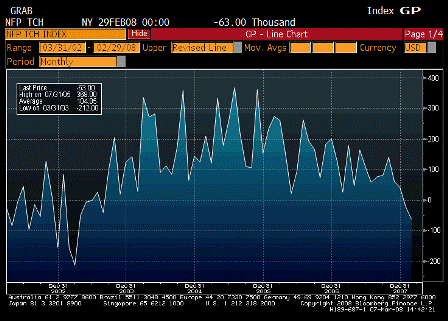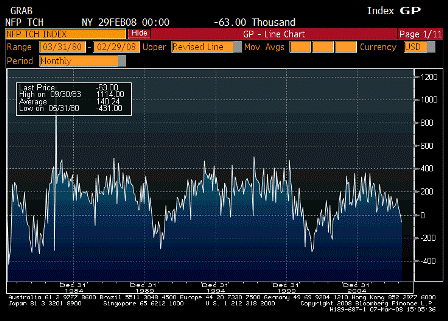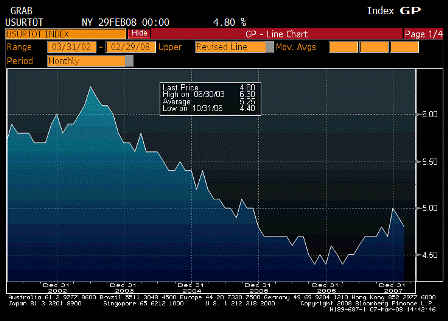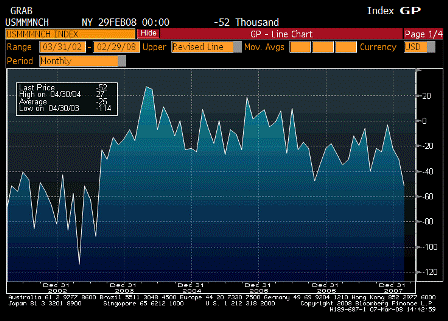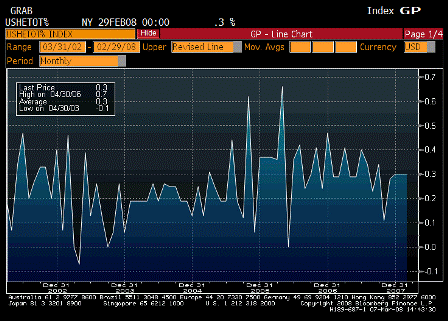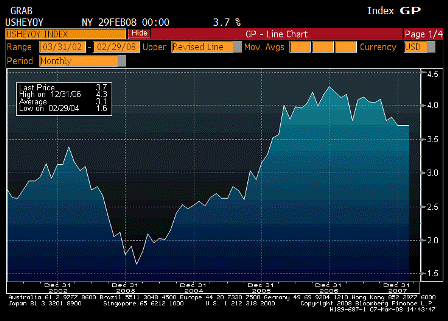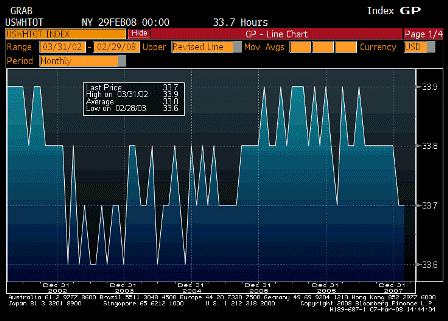While Fisher is perhaps the most hawkish voting member and voted against Bernanke at the last meeting, continuously rising crude/food prices and a not so large output gap are causing more voting members to firm their anti-inflation rhetoric in recent weeks:
by Naga Munchetty and Scott Lanman


(Bloomberg) Federal Reserve Bank of Dallas President Richard Fisher said investors shouldn’t assume that rising credit costs will force the central bank to cut interest rates as deeply as it did in January or in an emergency meeting.
“We reacted with very deliberate actions that took place over a very short timeframe” in January, Fisher said in an interview with Bloomberg Television in Paris. “That shouldn’t lead markets to expectations that we will continue to react in that manner.”
Fisher also downplayed speculation that the Fed is set to reduce its benchmark interest rate before policy makers’ next scheduled session on March 18. Yesterday, yields on agency mortgage-backed securities rose to a 22-year high relative to U.S. Treasuries, while the cost to protect corporate bonds from default climbed to a record.
“I would discourage you from thinking that simply because of a significant action in the credit markets, like we had yesterday, that suddenly we’re going to have an Open Market Committee meeting, and that suddenly we’re going to move Fed funds rates in response,” said Fisher. “It doesn’t work that way.”
Traders see a 100 percent chance that the Fed will lower its 3 percent benchmark rate by three-quarters of a percentage point this month, according to futures contracts. The probability a month ago of such a move was 30 percent.
`Process’ Turmoil
At the same time, Fisher said that the credit-market turmoil “has to be processed.”
That is, the Fed is more inclined to give markets time to work things out. While demand is weak, the output gap has remained modest.
And now, with inflation and inflation expectations elevated, they need a larger output gap to bring it down (rising MNOG).
The world’s 45 biggest banks and securities firms have written off $181 billion since the beginning of 2007, reflecting the collapse of the U.S. subprime-mortgage market.
Without a failure, so far, and without the feared supply-side constraints. Yes, credit standards have tightened, but not due to actual ‘money shortages’.
“There’s a danger if the Fed reacts to new information immediately,” said Fisher, 58, a former money manager and U.S. Senate candidate who joined the Dallas Fed in 2005. “But obviously we take into account all the information as closely as we can.”
Fed officials have cut the target for the overnight interbank lending rate by 2.25 percentage points since August, taking it to 3 percent. The 1.25 percentage point of reductions in January was the fastest easing of policy in two decades. Yields on two-year Treasuries fell to 1.41 percent at 11:55 a.m., the lowest since 2003, as traders anticipate further cuts.
Fisher was the lone voting member of the Federal Open Market Committee who dissented from the Jan. 30 decision to reduce the rate by a half point.
Jobs Report
The FOMC’s decisions in January were in response to a “weaker prospect for the economy,” Fisher said.
Which is why he voted against it. When the risks shifted from ‘market functioning induced collapse’ to ‘slowing demand/weaker GDP/larger output gap’, he stepped aside.
The U.S. Commerce Department releases February payroll- growth and unemployment figures at 8:30 a.m. Washington time today. The jobless rate probably rose to a two-year high and payrolls increased at a quarter of last year’s pace as builders and manufacturers fired more workers, economists said before the report.
A modestly larger output gap is expected. Fisher and others aren’t so sure that it will be large enough to bring down the rate of inflation, as it’s still going up even with current weakness.
Yes, inflation is a lagging indicator, but oil prices are a leading indicator and drive future inflation for years down the road.
Fisher was in Paris for a conference on globalization, inflation and monetary policy, hosted by France’s central bank. In a speech before the interview, Fisher said “persistent” increases in commodity prices make it harder for central bankers to determine precisely how much inflation may be rising.
Exactly. And so far, the rate cuts are seen to have been driving down the dollar, driving up crude prices and future inflation, and not doing a whole lot for market functioning.

